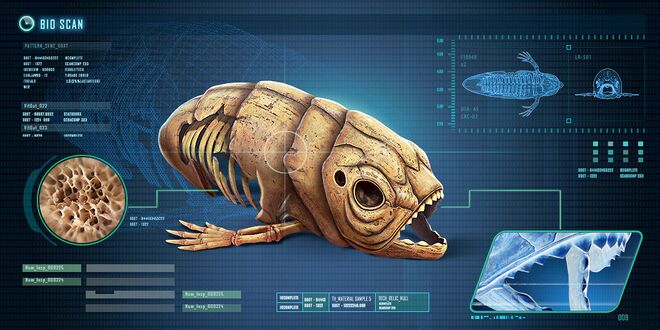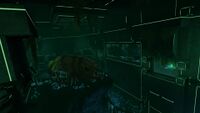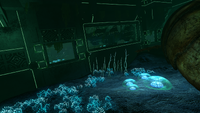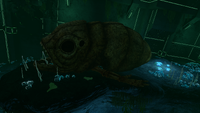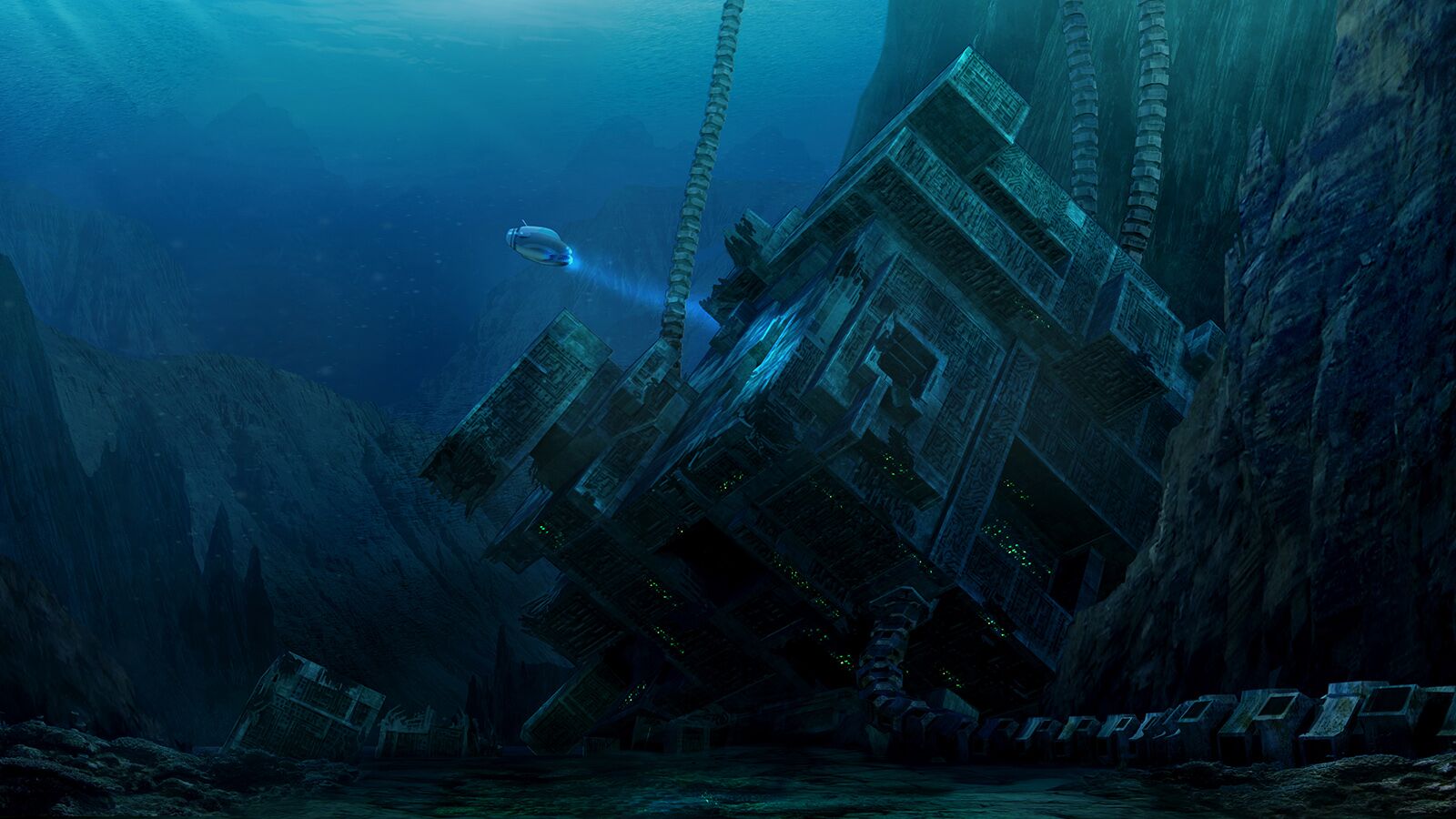Research Specimen: Difference between revisions
GemmaBeepo (talk | contribs) No edit summary |
GemmaBeepo (talk | contribs) No edit summary Tag: 2017 source edit |
||
| (48 intermediate revisions by 18 users not shown) | |||
| Line 1: | Line 1: | ||
__NOTOC__ |
|||
{{Spoiler}} |
{{Spoiler}} |
||
{{Deceased |
{{Deceased |
||
| |
|title = Research Specimen |
||
|image = Research Specimen Theta Fauna.png |
|||
| ⚫ | |||
|age |
|age = 1000 years |
||
|status = |
|||
* Presumed extinct, one set of remains |
|||
*Five living relatives: |
* Five living relatives: |
||
**[[Sand Shark]] |
|||
**[[ |
** [[Sand Shark]] |
||
**[[ |
** [[Boneshark]] |
||
**[[ |
** [[Biter]] |
||
**[[ |
** [[Blighter]] |
||
** [[Rockgrub]] |
|||
| ⚫ | |||
|biome = |
|||
| ⚫ | |||
** [[Disease Research Facility|Disease Research Facility Aquarium]] |
** [[Disease Research Facility|Disease Research Facility Aquarium]] |
||
|length = 21 meters |
|||
}} |
}} |
||
The '''Research Specimen''' was an individual of a large predatory species kept in the main aquarium of the [[Disease Research Facility]] for a long period of time for testing purposes. |
|||
This specimen is distantly related to five species still living on the planet today; the PDA notes shared skeletal traits with the Biter and Sand Shark, by extension this also makes |
This specimen is distantly related to five species still living on the planet today; the PDA notes shared skeletal traits with the [[Biter]] and [[Sand Shark]], by extension this also makes it a relative of the [[Boneshark]] and [[Blighter]], and a very distant relative of the [[Rockgrub]]. The presence of [[Bloodvine]] in the aquarium, a species otherwise absent from the Lost River biome, may imply this species inhabited the [[Blood Kelp Zone]]s. |
||
| ⚫ | |||
==Forearms== |
|||
{| class="article-table" style="width:100%; border:0; border-spacing:0" |
|||
The forearms are unique amongst its relatives and seem to have evolved independently as there is very little chance of relation to the [[Sea Emperor Leviathan|Sea Emperor]] and [[Sea Dragon Leviathan|Sea Dragon]] order and the skeletal structure of the arms differs greatly between them; whilst the Sea Dragon's - and presumably the Sea Emperor's - arms follow a more familiar structure with a ball and socket joint at the elbow, one upper bone; the humerus and two lower bones; the radius and ulna, Theta's arms are unique, with the humerus' equivalent made from two fused bones of equal size running parallel to each other, and rather than the ball and socket joint seen in the elbow of the Sea Dragon, it has a gliding joint composed of carpal bones. It also has five-digit hands rather than the Sea Dragon's four-digit hands. |
|||
The arms appear similar to a whale fin in shape and size, though since the PDA states they were forearms it is likely they were indeed arms with webbed hands on the end rather than fins. Although, the fact that they face backwards rather than forwards would have made them impossible to use as graspers like the Sea Dragon Leviathan. |
|||
==Eyes== |
|||
The secondary eyes appear considerably smaller and less developed that those found on the Sand Shark and Biter, in which they are indistinguishable from the front set of eyes in size and appearance. It can also be noted that the Boneshark lacks double eye sockets as well as any indication of their prior existence, meaning that the Boneshark must have diverged sooner than the others. |
|||
==Shell== |
|||
A solid external sell as well as an internal skeleton is commonplace amongst this group, with the Sand Shark, Boneshark, Theta and presumably the Rockgrub all exhibiting this adaptation, showing a preference for defensive capability over manoeuvrability in all species aside from the Biter and Blighter, which appear to have lost the external shell over time in favour of greater agility. |
|||
{{clear}} |
|||
| ⚫ | |||
{| style="width: 100%;" class="article-table sortable" border="0" cellpadding="1" cellspacing="1" |
|||
|- |
|- |
||
! |
! style="width:100%; text-align:center" | [[File:Fox3d-entertainment-giantfishskeleton.jpg|centre|660px]] |
||
|- |
|- |
||
| style="text-align:left; font-size:12px |
| style="text-align:left; font-size:12px" | |
||
The skeletal remains of a vast predator, housed within an artificial habitat. |
The skeletal remains of a vast predator, housed within an artificial habitat. |
||
1. Habitat:<br/> |
|||
The environment constructed to house the specimen suggests it was kept alive in containment for research purposes for months, or even years. Organic matter indicates the habitat once supported extensive plantlife, though it has since decayed. When the facility collapsed this specimen was either left to die, or killed on the spot. |
|||
| ⚫ | |||
2. Evolution:<br/> |
|||
| ⚫ | While it shares some skeletal traits with the biter and sand shark, including its distinctive double eye sockets, this fossilized specimen is significantly larger, and features unusual forearms rarely seen in aquatic species. This species has likely gone extinct in the past thousand years, and its evolutionary relatives have evolved almost beyond recognition. |
||
|} |
|} |
||
==Gallery== |
== Gallery == |
||
<tabber> |
|||
In-Game= |
|||
<gallery widths="200" spacing="small" navigation="true"> |
<gallery widths="200" spacing="small" navigation="true"> |
||
DRF24.jpg|Research Specimen |
DRF24.jpg|The Research Specimen in the Disease Research Facility |
||
Aquarium2.png|A view from behind |
|||
| ⚫ | |||
Aqauriumcreature.png|A close-up view of the remains |
|||
| ⚫ | |||
</gallery> |
</gallery> |
||
|-| |
|||
Models= |
|||
<gallery> |
|||
| ⚫ | |||
| ⚫ | |||
SpecimenThetaHighpoly.jpeg|Highpoly model from [https://sketchfab.com/3d-models/lost-river-fish-skeleton-highpoly-8c720e000c5f43e4b8e22e252444c667 Sketchfab] |
|||
</gallery> |
|||
</tabber> |
|||
{{Crater Fauna}} |
|||
[[fr:Spécimen de recherche Theta]] |
|||
[[Category:Story]] |
[[Category:Story]] |
||
[[Category:Lost River]] |
[[Category:Lost River]] |
||
[[Category:Leviathan Class]] |
|||
[[Category:Skeletal Remains]] |
[[Category:Skeletal Remains]] |
||
[[Category:Extinct Species]] |
[[Category:Extinct Species]] |
||
| ⚫ | |||
<div style="position:fixed; display:block; margin-left:auto; margin-right:auto; width:100%; top:-20px; left:0px; z-index:-1">[[File:Precursorlostriver.jpg|center|2000x2000px]]</div> |
|||
Latest revision as of 11:25, 27 October 2024

|
Read at own risk This article contains unmarked spoilers. Players new to the game would want to avoid or be cautious toward this article. |
<infobox layout="stacked">
<title source="title" style="font-weight:bold; text-align:center;"> <default>Research Specimen</default> </title> <image source="image">
</image> <label>Age</label> <label>Status</label> <label>Biome</label> <label>Length</label> <label>Coordinates</label> <label>GoTo</label> <label>Debug Spawn</label> </infobox> The Research Specimen was an individual of a large predatory species kept in the main aquarium of the Disease Research Facility for a long period of time for testing purposes. This specimen is distantly related to five species still living on the planet today; the PDA notes shared skeletal traits with the Biter and Sand Shark, by extension this also makes it a relative of the Boneshark and Blighter, and a very distant relative of the Rockgrub. The presence of Bloodvine in the aquarium, a species otherwise absent from the Lost River biome, may imply this species inhabited the Blood Kelp Zones.
Data Bank Entry
|
The skeletal remains of a vast predator, housed within an artificial habitat. 1. Habitat: 2. Evolution: |
Gallery
<tabber> In-Game=
|-| Models=
</tabber>
Lua error in package.lua at line 80: module 'Dev:Navbox' not found.

